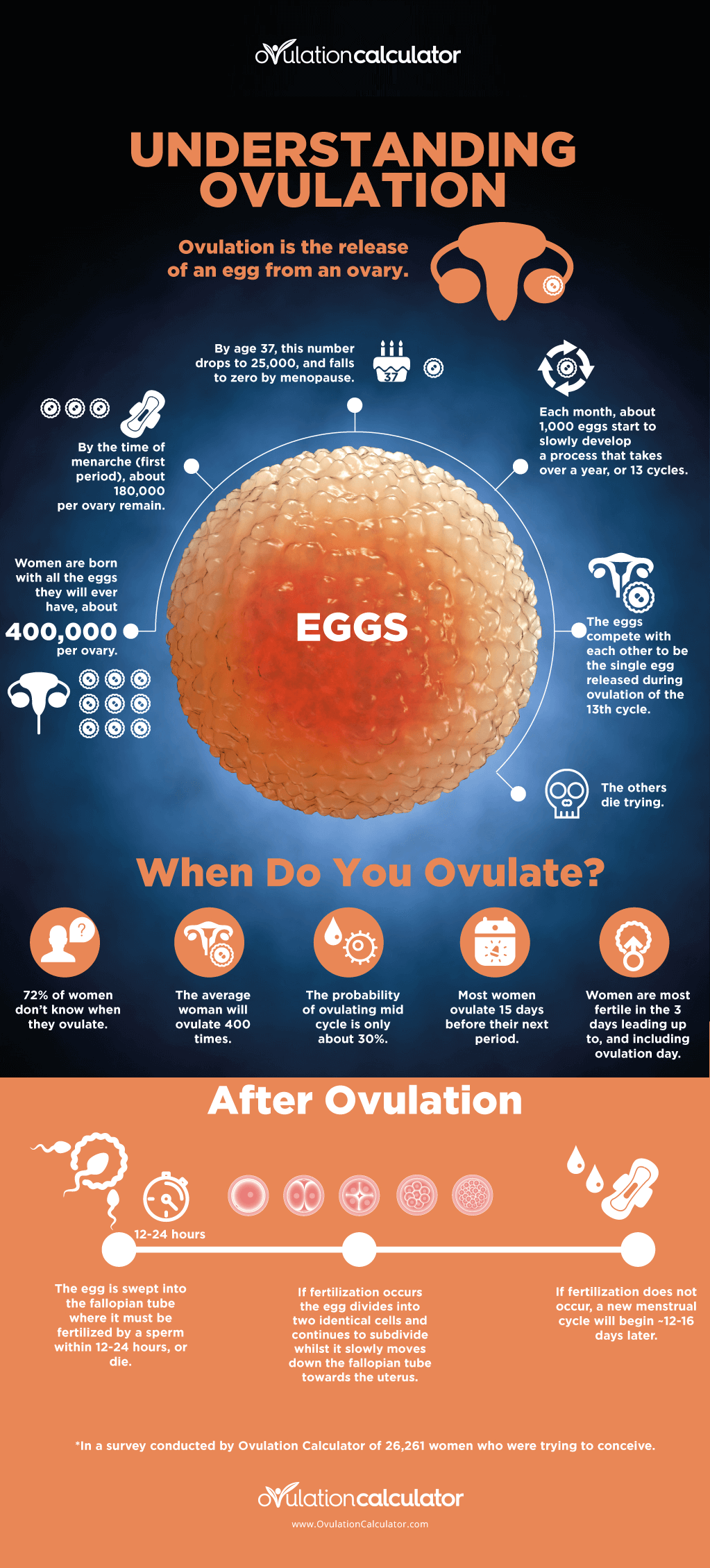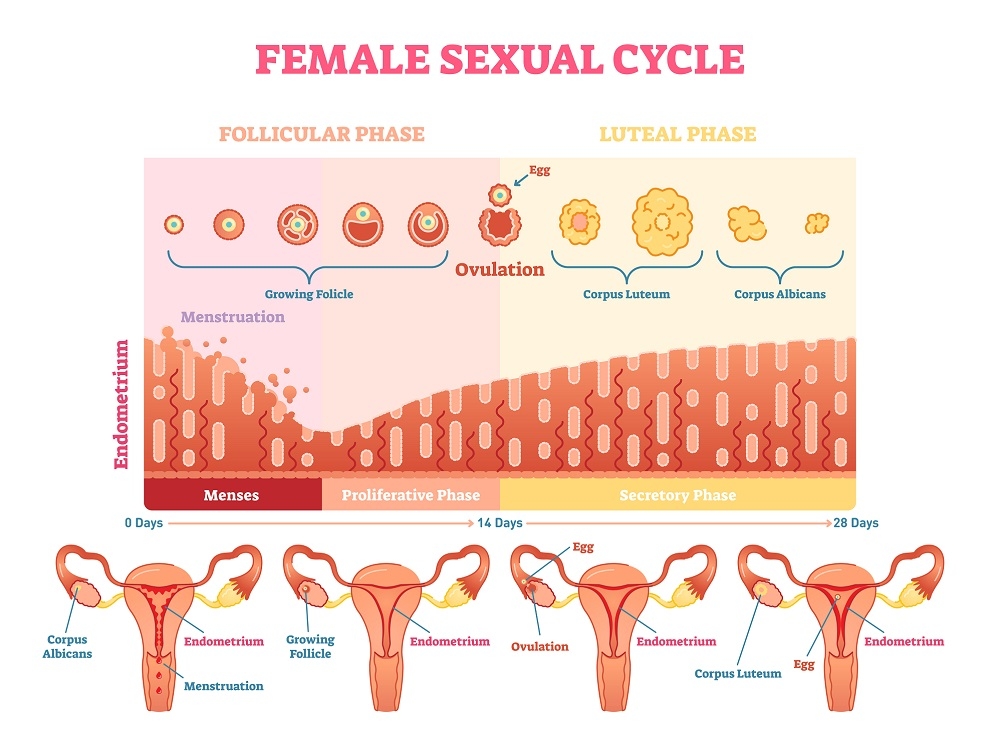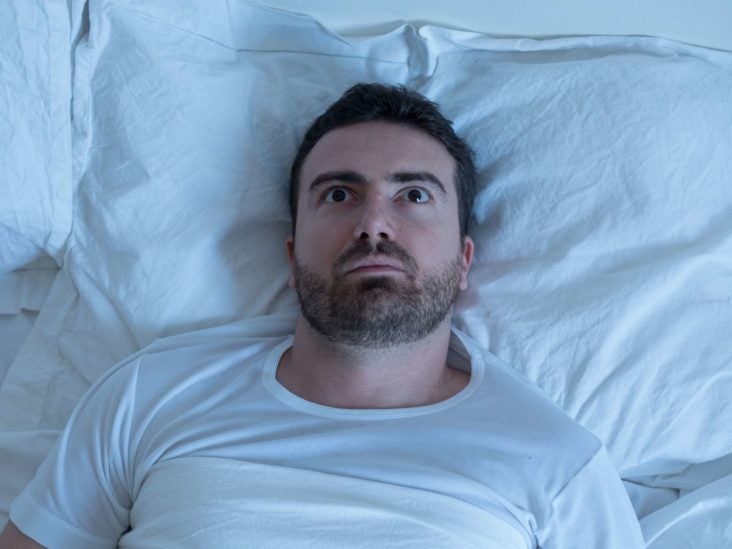This means that ovulation will occur 16 days after your period starts. Your chance of getting pregnant is highest when live sperm are present in the fallopian tubes during ovulation.
 Ovulation Understanding Ovulation To Get Pregnant
Ovulation Understanding Ovulation To Get Pregnant
But in most women ovulation occurs in the four days before or after the midpoint of the menstrual cycle.

After period when does ovulation occur. However some women have a shorter or a longer menstrual cycle. Most women ovulate anywhere between Day 11 Day 21 of their cycle counting from the first day of the LMP. After a day the egg will die or dissolve if it isnt.
In this phenomenon an egg is released from the follicles of the ovaries and travels from there to the fallopian tube to get fertilized. Menstruation during ovulation cases. Menstruation or a period is the bleeding that occurs when the endometrium is shed 12 to 16 days after ovulation.
In cases when the menstrual cycle lasts about 21 days and the menstrual period bleeding lasts for about 7 days there is a great possibility of having the ovulation right after period. If your period normally last for 5 days it stops on the 7th of march which is 9 days before ovulation. The most common pattern is for ovulation to occur 14 days before your next period is due.
If you have a 28-day cycle youll usually ovulate some time between day 10 and day 15 of your cycle. The only data these calculators use is your average cycle length. If your average menstrual cycle is 28 days and the first day of your cycle is Day 1 of your menstrual period day 14 in your cycle is your day of ovulation and your most fertile days are days 12 13 and 14.
Ovulation is a phenomenon that occurs every month in females of reproductive or childbearing age. Basically your body is jumping the gun and letting the egg go before it has fully ripened. For example if the cycle is 30 days and the luteal phase is 15 days or 12 days then the date of ovulation will be.
If you have a regular 28 days cycle we can predict your next period and next ovulation. The process of ovulation begins with your bodys release of. It lasts about 24 hours.
It depends on when to wait for the period after ovulation. Ovulation occurs on the 16th DC. A person with a 28-day cycle for example will have their fertile window 5 days before the ovulation date.
According to the ACOG ovulation occurs around day 14 of the menstrual cycle. A womans monthly menstrual cycle is measured from the first day of the menstrual period until the first day of the next period. Lets say period started 2nd of March your next period and ovulation days respectively are 30th and 16th December.
How many days after period do you ovulate if your period cycle last 28 days. In general ovulation occurs 12 to 16 days before the next menstrual cycle begins. Ovulation usually occurs between day 11 and day 21 of the cycle counting from the first day of the last period.
If you have a 30-day cycle then ovulation will occur approximately on day 16 of your cycle. How long does it last. In general ovulation occurs in the four days before or four days after your cycles midpoint.
The first day of your period when you start bleeding is counted as the first day of your cycle. Ovulation usually occurs in and around the 14th day of the menstrual cycle consisting of 28 days. Women who exclusively breastfeed feeding the baby only with breastmilk usually dont begin to ovulate again until five to six months after the baby is born.
These are the days pregnancy is most likely to occur. The average womans menstrual cycle is between 28-32 days though shorter or longer cycles do occur in some women. One of your ovaries will release an egg ovulation about 14 days before your period starts.
With this definition of a period you cannot ovulate while on your period. How Many Days After Your Period Do You Ovulate. Every woman is different however and ovulation may begin again at different times.
Ovulation can occur before a woman has her first period after childbirth. 30-15 15th DC or 30-12 18th DC And the online calculators will always show the result. But if your cycles arent regular this method wont be very helpful since you dont know exactly when to expect your next period.
Understanding your menstrual cycle Your menstrual cycle begins on the first day of your period and continues up to the first day of your next period. You ovulate about 14 days before your period starts. Ovulation can be calculated by starting with the first day of the last menstrual period LMP or by calculating 12-16 days from the next expected period.
30 days minus 14 16. Ovulation occurs 10-14 days before your next period so you will get an approximate ovulation date by subtracting 14 from the number of days in your cycle eg. In an average 28-day menstrual cycle ovulation typically occurs about 14 days before the start of the next menstrual period.
Ovulation happens at around day 14 if you have a 28-day cycle right in the middle of your menstrual cycle. Youre most fertile at the time of ovulation when an egg is released from your ovaries which usually occurs 12 to 14 days before your next period starts. Ovulating before Day 10 of your cycle known as a short follicular phase is usually a sign you are releasing immature eggs 1.
However some women experience mid-cycle or ovulatory bleeding bleeding that occurs around ovulation and may mistake it for a period.
The episodes happen more routinely compared to horrors which are often random. Unlike nightmares where frightening dreams occur both children and adults who struggle from night terrors sleep do not dream at all.
 Know Night Terrors In Adults Before It S Too Late
Know Night Terrors In Adults Before It S Too Late
You go through the REM sleep phase when you are falling asleep waking up and during sleep.

Do night terrors occur in rem sleep. Nightmares usually occur in the middle of the night or early morning when REM sleep and dreaming are more common. The latter two are when you sleep deeply. Night Terrors in Children.
Night terrors typically happen during non-REM sleep specifically stage-three sleep. Nightmares and sleep terrors have several distinguishing characteristics 8. This makes them look more like panic attacks than nightmares but theyre not.
Sleep terrors dont involve a full awakening. Night terrors are different from nightmares which occur during REM sleep. Night terrors are characterized by physical symptoms associated with fear such as accelerated heartbeat and sweating.
Night terrors are episodes of extreme panic or fear that usually occur earlier in the night as opposed to nightmares which tend to occur later in the night. Nightmares are scary dreams that usually occur during REM sleep which is when dreams occur Dimitriu says. Also night terrors occur during the NREM stage of sleep while nightmares happen during the REM stage.
NREM sleep happens first and is divided into three stages. Night terrors sleep terrors occur before the dream state of REM sleep in the phase just before deep sleep called the slow-wave sleep phase. Most dreaming occurs during REM sleep.
Nightmares happen during REM sleep while sleep terrors happen during non-REM NREM sleep. This stage is also called deep sleep and is when according to the ASA extremely slow brain waves start to. As i am a professional hypnotherapist i could see practically from many people who were in trance.
While still asleep the sleeper could. Instead a person remains mostly asleep and difficult to awaken. Approximately one in four children ages five to 12 has frequent nightmares and they are not usually cause for concern though they may occur more often when the person feels stressed out or anxious.
Nightmares occur during REM sleep which typically lasts longer in the early morning hours. Night terrors also called sleep terrors are a type of parasomnia classified as an arousal disorder that occurs during non-REM NREM sleep. They happen to both.
The person is not incited to the outburst through any form of imagery or sound that a nightmare would include but simply a deep sense of terror and fear that they cannot shake. About 1 to 6 in 100 children have night terrors also known as sleep terrors. Night terrors happen during non-REM sleep usually about 90 minutes after a child falls asleep.
In addition nightmares appear ordinarily during REM sleep in contrast to night terrors which occur in NREM sleep. Nightmares tend to happen during rapid eye movement sleep REM towards the end of a nights sleep. At this stage your brain is in an active state and you can see dreams or various kinds of hallucinations.
A distinction between night terrors and epileptic seizure is required. The most terrifying thing about sleep paralysis is that its usually accompanied by vivid nightmares and sometimes hallucinations such as attacks of demonic creatures. This difference is most likely due to the phase of sleep in which night terrors occur.
Only at rem moments we could see their eyes wandering that time they dream or creat some mental picture inside their mind. Night terrors usually occur at the beginning of the night. They usually occur during the first 3 to 4 hours of the night.
This means nightmares commonly occur in the second half of the night or early morning. Night terrors a sleep disorder typically occurs in children aged 3-12 years. It is only in rem sleeping only the dream occurs.
Are night terrors a sign of mental illness. The main difference is that night terrors occur during NREM sleep while nightmares occur during REM sleep. The usual window for night terrors to occur is as the sleep cycle moves from the deepest stage of NREM into the lighter REM sleep.
Finally individuals with nightmares can wake up completely and easily and have clear and detailed memories of their dreams. Night terrors are characterized by frequent recurrent episodes of intense crying and fear during sleep with difficulty arousing the child. They are actually related to other.
Its rare to see night terrors manifest alongside a diagnosable mental illness like anxiety or depression.
The final growth spurt begins sometime between age 9-15. In general baby growth spurts occur around the following times.
 Recognizing Handling Growth Spurts In Babies Mama S Organized Chaos Baby Growth Spurts Baby Growth New Baby Products
Recognizing Handling Growth Spurts In Babies Mama S Organized Chaos Baby Growth Spurts Baby Growth New Baby Products
In young babies they usually last for one day or two days Hermanussen 1998.

When do infant growth spurts occur. At 3 months 6 months and 9 months. Between 4 and 6 weeks. Heres when you may see growth spurts in your baby.
Some experts believe that growth spurts are more likely at certain points in your babys first year. These growth spurts typically happen when your baby is around 2-3 weeks 6 weeks 3 months and 6 months old. Growth spurts occur a lot during the first year of the baby.
After that they become more spread out. Growth spurts dont stop after the first year. Between 6 and 8 weeks.
For boys puberty starts around age 11-12 and completes around age 16-17. Common times for growth spurts are during the first few days at home and around 7-10 days 2-3 weeks 4-6 weeks 3 months 4 months 6 months and 9 months more or less. During the puberty growth spurt boys gain up to 4 inches a year while girls grow up to 3 inches a year.
Growth spurts can happen at any time and every baby is different. In the first month alone growth spurts can happen every few days or even weekly. This will be followed by another growth spurt at about 8 weeks.
They can cause your baby to nurse longer and more often. Generally infant growth spurts tend to occur around 10 days three weeks six weeks three months four months six months and nine months of life. When do growth spurts happen.
Some mothers have noticed growth spurts in their child till the time they reach four years of age. When do growth spurts happen and how long do they last. The same is true of weight gain.
Each babys growth pattern is different so try not to worry if your baby doesnt seem to be having growth spurts at these times. Babies go through many growth spurts during the first year of life. While every baby is unique its likely youll experience quite a few growth spurts during the first year.
Although growth spurts can happen anytime during the first year your baby will most likely have his initial spurt between 1 and 3 weeks and another between 6 and 8 weeks. According to the American Academy of Pediatrics AAP infants tend to enter growth spurts at the beginning of the second week roughly 10 days and then again at three weeks six weeks three. Between 1 and 3 weeks Between 6 and 8 weeks At around 3 months.
When do babies have growth spurts. For girls puberty typically begins between the ages of 10-11 and is usually completed by age 15-17. There are often around 4-5 growth spurts in your babys first year but not always explains Health Visitor Dawn Kelly.
Constitutional growth delay Also known as delayed puberty children with constitutional growth delay will be normal-sized babies but will slow down on growth between the ages of 6 months and 2. The third growth spurt is going to be at about three months of age. In older babies they can last up to a week Wagner 2012.
Growth spurts can happen at any time. After that you can expect more at 3 months 6 months and 9 months. According to the American Academy of Pediatrics AAP infants tend to enter growth spurts at the beginning of the second week roughly 10 days and then again at three weeks six weeks three months and six months.
Some children grow at a steady pace throughout their toddler stage while others can gain a couple of inches over the course of a few months. Some experts believe that growth spurts are more likely at certain points in your babys first year. This can vary widely though.
You might notice growth spurts around certain ages. 1 to 3 weeks of age 6 weeks. But your babys growth spurts may not happen at these exact times.
Your toddlers growth spurt will happen anytime between the ages of 2 and 4. 1-3 weeks 4-6 weeks. Growth spurts can happen any time and anywhere but there are some incredibly loose periods of time when you may be able to reasonably expect your baby to go through one.
Newborn growth spurts during the first few daysusually night 2which is more of a protest of leaving your womb rather than an actual growth spurt. Your babys timing might be different. Dawn suggests these tend to occur at approximately.
Between 2 and 3 weeks. Babies dont read calendars however so your baby may do things differently. Babies can have growth spurts during the first two-six weeks three months four months six months and nine months.
After that baby will most likely have about 5 growth spurts during the first year of life with the first one being at about one to three weeks of age when the babys head will grow significantly.